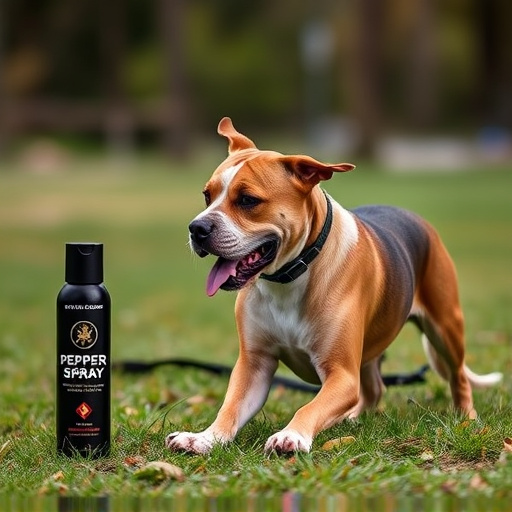Mace pepper spray for dog control must be stored between 50-70°F (10-21°C) in cool, dry, sealed areas away from sunlight and heat sources to maintain potency and shelf life. Extreme temperatures and conditions can degrade its active ingredients, reducing performance. Safe use requires adhering to storage guidelines, wearing protective gear, using it responsibly as a last resort, and understanding local laws and ethical considerations.
“Unleashing control and safety in dog training, mace spray has emerged as a professional-strength tool. This article delves into the intricacies of mace pepper spray for dogs, offering a comprehensive guide from a seasoned expert’s perspective. We explore optimal storage temperature guidelines to ensure its effectiveness, delve into safe application techniques, and navigate legal implications crucial for responsible use. By understanding these key aspects, dog trainers and handlers can harness the power of mace spray while adhering to strict regulatory compliance.”
- Understanding Mace Pepper Spray for Dogs: A Professional's Perspective
- Storage Considerations: Optimal Temperature Guidelines for Effective Mace Spray
- Safety and Application Techniques: Ensuring Responsible Use in Dog Training and Control
- Legal Implications and Regulatory Compliance: Navigating the Use of Mace Spray on Dogs
Understanding Mace Pepper Spray for Dogs: A Professional's Perspective
Mace pepper spray for dogs is a powerful tool used by professionals in law enforcement, animal control, and security to subdue and control aggressive or dangerous canines. From a professional’s perspective, understanding the dynamics of mace pepper spray storage temperature guidelines is paramount to ensuring its effectiveness and safety. Extreme temperatures can significantly impact the potency and shelf life of the spray, making it crucial for handlers to store it appropriately.
Optimal storage involves keeping the spray in a cool, dry place, typically between 50-70°F (10-21°C), away from direct sunlight or heat sources. Adhering to these mace pepper spray storage temperature guidelines helps maintain the integrity of the chemical composition, guaranteeing that each deployment delivers the intended result. Proper storage also extends the lifespan of the product, ensuring it’s ready when needed for effective canine control.
Storage Considerations: Optimal Temperature Guidelines for Effective Mace Spray
Mace pepper spray, especially in professional-strength formulations designed for dog control, requires proper storage to maintain its effectiveness. Optimal storage conditions play a crucial role in preserving the potency and functionality of the spray. The recommended temperature for storing mace pepper spray ranges between 50°F (10°C) and 70°F (21°C). Extreme temperatures can cause chemical reactions that degrade the active ingredients, reducing the spray’s impact.
It is essential to keep the spray away from direct sunlight and heat sources. High humidity levels should also be avoided, as these conditions can lead to premature degradation. Ideal storage involves placing the spray in a cool, dry place, ensuring it remains sealed to prevent any contamination or moisture ingress, which could compromise its performance when needed.
Safety and Application Techniques: Ensuring Responsible Use in Dog Training and Control
When using mace spray, especially professional-strength varieties designed for dog control and training, safety is paramount. It’s crucial to understand that pepper spray can have severe physical and psychological effects on both dogs and humans, so responsible use is essential. Follow these guidelines for safe application and storage: keep the spray in a cool, dry place, adhering to mace pepper spray storage temperature recommendations. Ensure proper handling techniques by wearing protective gear and using the spray only as a last resort, when other methods have failed or are unsafe.
Trainers and handlers should be well-versed in de-escalation tactics and alternative control methods before resorting to pepper spray. Application technique matters; aim for the eyes, nose, and mouth, where the irritant will quickly disperse and cause temporary but effective disruption. Regularly review safety protocols and stay updated on best practices to ensure ethical and responsible use, minimising potential harm while maximising training effectiveness.
Legal Implications and Regulatory Compliance: Navigating the Use of Mace Spray on Dogs
The use of mace spray, especially in professional settings involving dogs, comes with a host of legal and regulatory considerations. It’s crucial to understand that the application of pepper spray on animals is subject to strict local, state, or national laws and guidelines, which vary significantly across regions. Before employing this method, professionals must familiarize themselves with these regulations, ensuring they meet all storage temperature guidelines for mace pepper spray. Failure to comply can result in severe penalties, including fines and legal repercussions.
Navigating these laws requires a thorough understanding of when and how pepper spray can be used on dogs while adhering to ethical standards. Professionals should also be aware of alternative methods and de-escalation techniques to avoid the necessity of using such force. Staying informed about updates in regulatory compliance is essential to ensuring safe and legal practices when dealing with potentially aggressive animals.
Mace pepper spray, when used responsibly and in accordance with legal guidelines, can be a valuable tool for professional dog trainers and handlers. Understanding the optimal storage temperature guidelines (typically below 80°F or 27°C) ensures its effectiveness, while adhering to safety protocols and legal implications is paramount. By following these Storage Temperature Guidelines and implementing safe application techniques, professionals can leverage mace pepper spray as a strategic aid in dog training and control, promoting both animal welfare and public safety.
